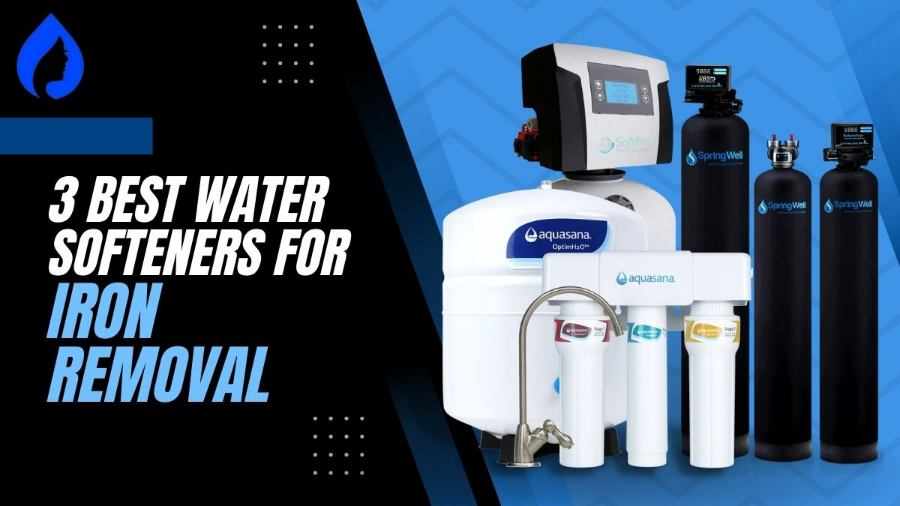
We have spent 100+ hours testing 37+ water softeners to find the 3 best water softeners for iron removal in January 2024 with 3 runners-up choices.
We’ve reviewed and rated them on critical parameters like iron removal capacity, water quality, and flow rate so that you get the best value for money.
Here are the details!
3 Best Water Softeners For Well Water: Quick Preview
| Image | Product | Price |
|---|---|---|
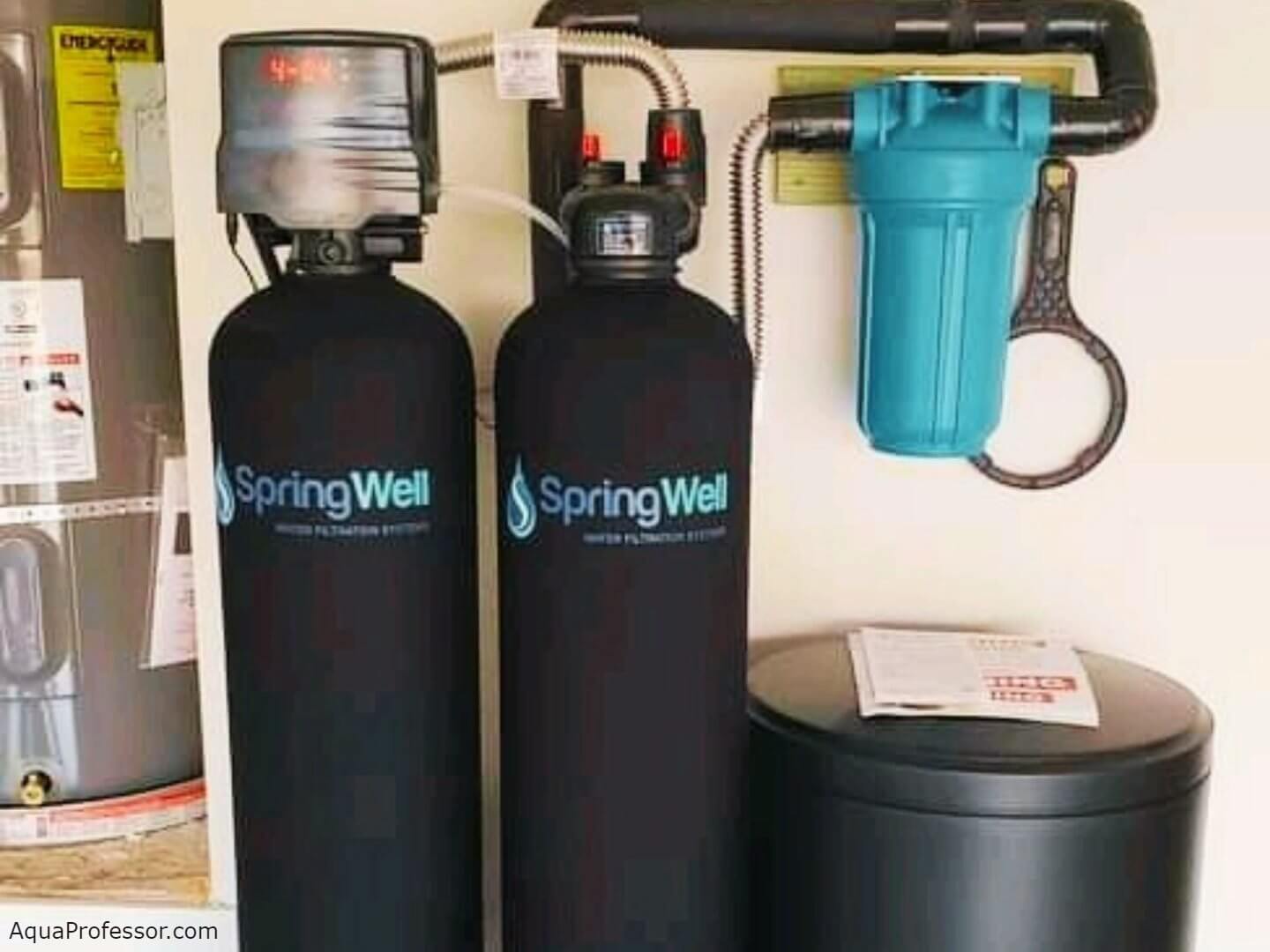 | SpringWell SS1 Salt-Based Water SoftenerBest Overall
| Check OfferFull Review>>> |
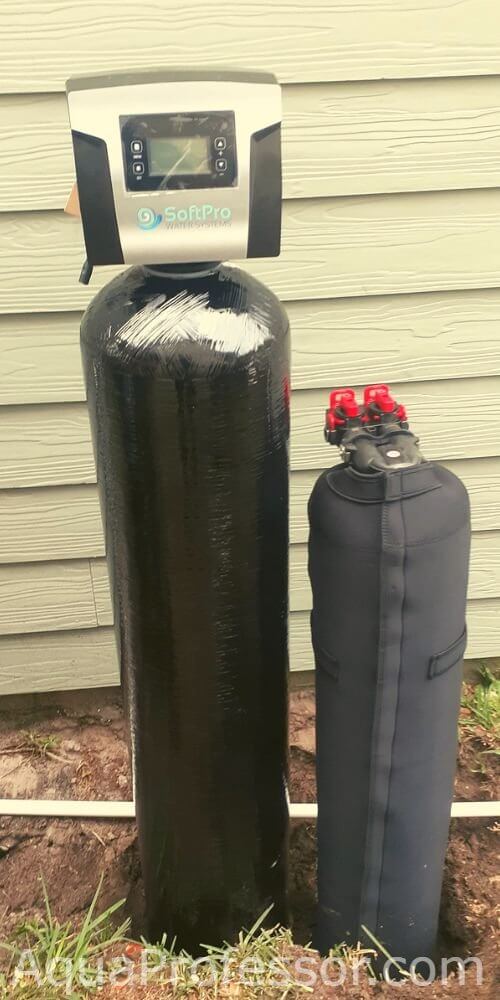 | SoftPro® Elite Water Softener for Well WaterBest For Budget
| Check OfferFull Review>>> |
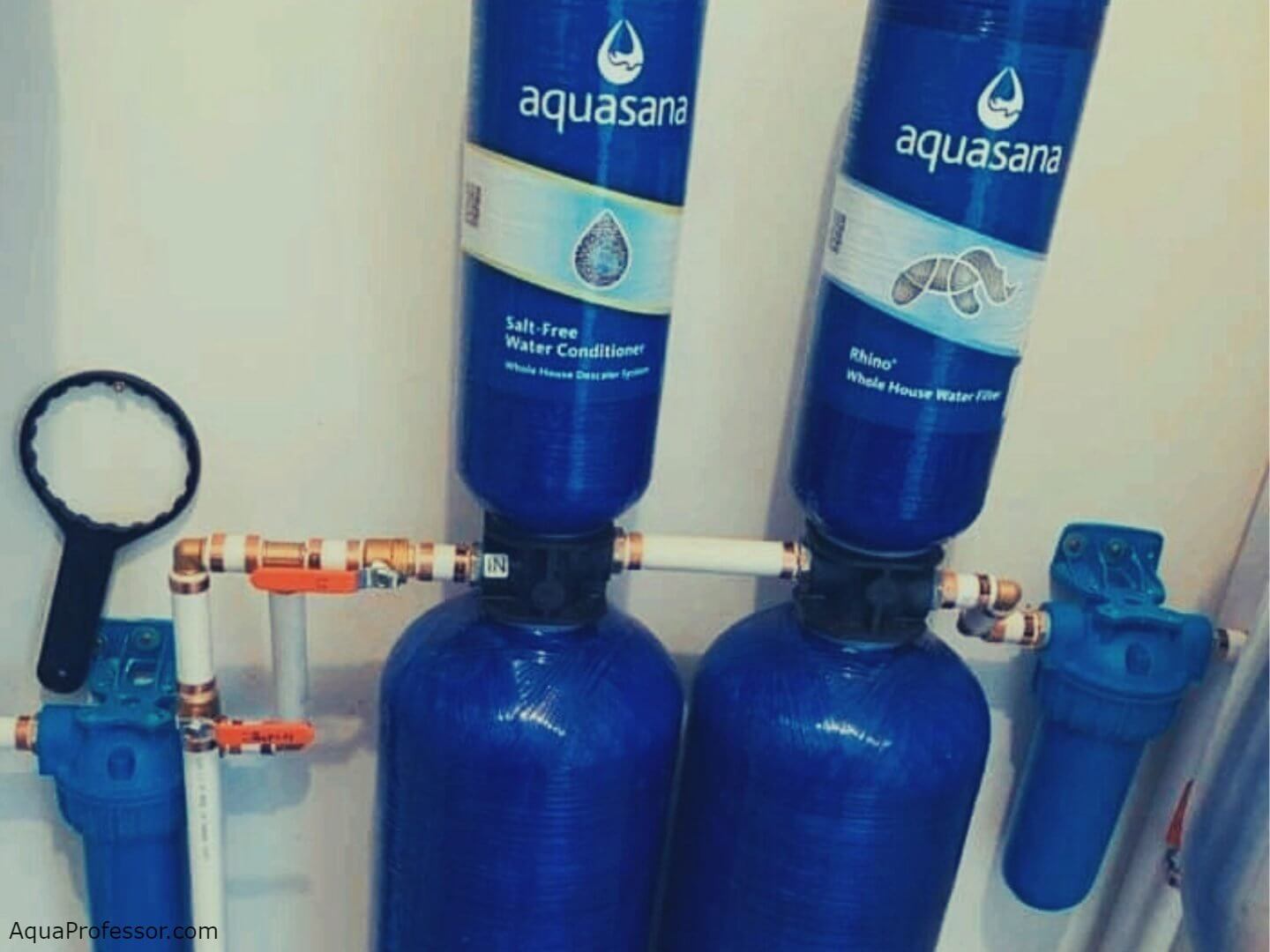 | Aquasana EQ-1000-AST Whole House FilterBest Water Softener Alternative
| Check PriceFull Review>>> |
Here's How We Test Products At Aquaprofessor
- 3 Best Water Softeners For Well Water: Quick Preview
- Best Water Softener Salt for Iron Removal: Detailed Reviews
- Iron Reducer Water Softener For Iron-Contaminated Well Water
- Expert Buying Guide To Choose Water Softeners For Well Water Contaminants
- How Do Water Softeners Remove Iron From Well Water?
- Why Do You Need To Remove Iron From Well Water?
- Pros and Cons of Using Water Softener To Remove Iron In Well Water
- Types Of Water Softeners For Iron Removal
- Difference between Water Softeners and Water Conditioners
- Water Softener Maintenance Tips
- Best Water Softener For Iron Removal FAQs
Best Water Softener Salt for Iron Removal: Detailed Reviews
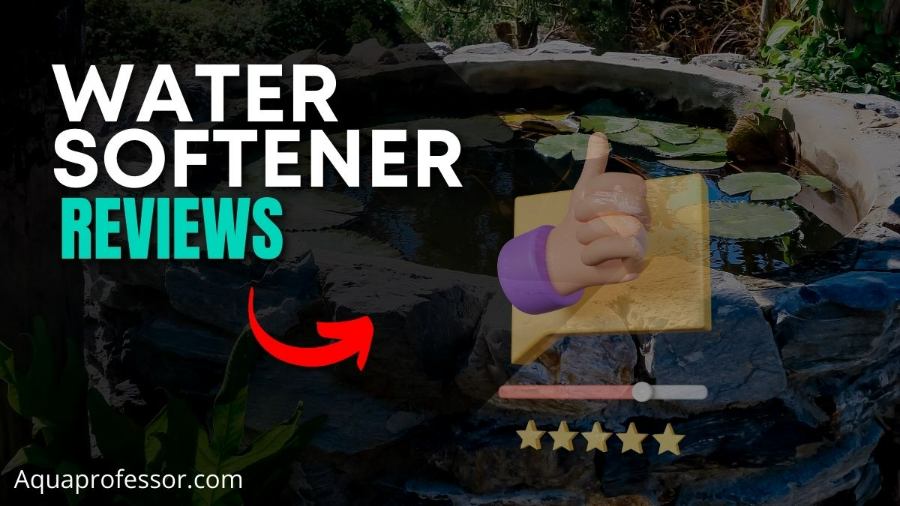
Did you know that even as low as 0.3ppm in well water, iron concentration can cause hard water problems like build-up around faucets and bitter water taste?
It is not a one-off issue; 85% of the US population faces water hardness problems caused by excess iron.
Water softeners are the simplest way to solve this problem, but with thousands of options in the market, it’s hard to find an efficient system exclusively designed for iron removal.
That’s why we are here with detailed reviews of top iron treatment systems for well water:
| Water Softener System | Iron Removal Capacity | Max Family Size | Process Adopted | Certifications |
| SpringWell SS1 | ≤ 10 ppm | 1 – 6 People | Ion Exchange | NSF certified components |
| SoftPro Elite | ≤ 3 ppm | 1 – 6 People | Ion Exchange | NSF certified components |
| Aquasana EQ-1000-AST | < 1 ppm [treatment] | 1-5 People | 3-stage salt-free filtration with activated carbon | NSF/ANSI 42 |
Also Read: What Is The Best pH Neutralizer For Well Water?
SpringWell SS1 Salt-Based Water Softener: Best Overall
Pros
- Great drinking water taste
- High iron reduction rate11-20 GPM flow rate
- Available in 3 Grain capacities
- Digital controller with Bluetooth connectivity
- Resin can last 6-10 years
- Tanks can last 18-25 years
- 6-month satisfaction guarantee and lifetime warranty
Cons
- High upfront cost
- Some customers prefer metal fittings over plastic
This SpringWell Salt-based water softener has enjoyed a good reputation in the market as it greatly improves the drinking water taste and also treats hard water.
In addition, this water softener and filter combo can remove 8 ppm of iron.
Let’s dive into further details:
Iron Removal Capacity
A SS1 water softener is best for 3 ppm iron levels; however, its reduction rate can go as high as 8 ppm. This reduction rate applies to ferric (Fe3+), ferrous (Fe2+) ions and other minerals like hydrogen sulfide and manganese.
Iron Removal Process
The SpringWell softener system uses air injection treatment and the classic ion-exchange process as a combination unit. The ferrous ions are attracted to the resin beads of the main mineral tank and get exchanged with salt ions.
On the other hand, ferric ions, being insoluble and inert, are first oxidized through an air injection filter to produce oxide salts. These ferric oxides are then filtered out through a porous membrane.
Installation and Maintenance
Although the SS1 softener manual has clear and easy instructions, you might need professional help for its installation due to its heavy weight and plastic fittings.
Maintenance Hack!
As far as maintenance is concerned, the salt pellets need to be replaced timely. However, you will be happy to know it needs less refilling than other units in this list. In addition, the filter housing doesn’t require much cleaning.
Water Flow Rate and Grain Capacity
Springwell SS1 has an excellent flow rate of 11-20 GPM, depending on model size. 11 GPM flow rate is sufficient for a home with 1-3 bathrooms, but if you have more than them, go for the 20 GPM unit.
The unit is available in three-grain capacities: 32000, 48000, and 80000. So, you can choose a model according to your water usage.
Customer Support, Warranty, and Certifications
Springwell provides a 6-month satisfaction guarantee and a lifetime warranty on this product. Plus, it’s built from NSF-certified components.
The customer service department is open five days a week. You can contact them through their phone number, email address, and online chat support on their official website.
However, there have been many customer complaints of late replies and poor communication, which is concerning.
Who is it best for?
People with high iron levels in water (both ferrous and ferric), along with sulfides and manganese, can go for SpringWell SS1 salt-based water softener. The reduction rates of this system are higher than other competitive units.
SoftPro® Elite Water Softener for Well Water: Detailed Review
Pros
- Great price
- 3 ppm iron reduction rate
- 10-23 GPM flow rate
- 24k-80k grain capacity
- Precision brining to save salt and water
- Good for customization
- Automatically refreshes settings if unused for days
Cons
- Tricky installation
- More space consuming due to more width
SoftPro Elite is a superb budget option with all water-softening benefits. Although it’s comparatively new to the market, SoftPro has built trust and made a name in the water treatment systems market.
So let’s disclose more of its features:
Iron Removal Capacity
SoftPro Elite can only remove Ferrous ions from the water with an average reduction rate of 3 ppm. It can also remove other impurities like sulfur and heavy metals. The main tank is filled with fine resin mesh for better iron removal.
Iron Removal Process
Like most water softeners, SoftPro Elite uses the ion-exchange mechanism to absorb iron and other minerals.
Resin Prevents Clogging
The resin keeps the mineral salts in exchange for potassium or sodium ions of the brine. Thus, the outcoming water is softened and can no longer cause scale buildup, clogging, or staining.
Installation and Maintenance
The package has an instruction manual to guide you in installing the system. The instructions may seem pretty easy to understand, but do keep a handyperson along for lifting and pipe fittings.
In addition, it has a built-in bypass, stainless steel hoses, and an LCD touchscreen. Its maintenance includes the replacement of salt pellets.
Here’s what you should do:
Water Flow Rate and Grain Capacity
Softened water from SoftPro Elite has a flow rate of 10 to 23 GPM depending on the model you are going for. The more family members and bathrooms in the home, the higher the required flow rate.
Moreover, you can choose from 24000 to 80000-grain capacity as per your requirement. Usually, a 48,000-grain capacity is sufficient for most families.
Customer Support, Warranty, and Certifications
Customer support of SoftPro Elite is open from 9 a.m. to 7 p.m. from Monday to Friday.
You can get their contact details and live chat facility on the official website. According to customers, they are quick to respond and solve your doubts. You can also enjoy a lifetime warranty on the tank and control valve.
SoftPro Elite is built from NSF-certified components.
Who is it best for?
People with a lower budget who want the same water-softening efficiency as high-end products can use this system. Also, it will allow you to customize the water treatment system with additional filters.
Aquasana EQ-1000-AST Whole House Filter: Detailed Review
Pros
- Massive filtration capacity of 1 million gallons
- 1 ppm iron reduction rate
- 7 GPM Flow Rate
- 3-stage filtration
- Professional grade brass fittings and bypass
- 10 years of lifespan
- Eco-friendly (salt-free softener)
- Easy maintenance
Cons
- Costlier than other models
- Doesn’t remove all impurities
- Installation requires expert help.
The Aquasana EQ-1000 is a popular water filter in the market. This salt-free water softener system is an eco-friendly option to soften water and has been certified under NSF standard 42.
Let’s know more about this unit:
Iron Removal Capacity
Aquasana EQ-1000’s activated carbon filter treats iron concentrations of less than 1 ppm and reduces scale build-up on plumbing and fixtures.
Get Rid Of Heavy Metals
Besides, it can also remove other impurities, including heavy metals, chlorine, chemicals, and microbes.
Iron Removal Process
Water passes through 3 stages in the Aquasana water filtration system. This multiple-tank purification process optimizes contact time between filter media and water.
Installation and Maintenance
Aquasana EQ-1000 whole house water filter system requires alterations and adjustments during installation, according to your house’s plumbing.
Conclusion:
Hiring a professional is preferred. Some people use pipe connections with the same diameter as the house’s pipeline to prevent reduced water flow rate. Overall, the brass fittings and filtration tank are leak-proof, durable, and sturdy.
Filtration elements must be replaced every 2 – 6 months, depending upon your water usage, to prevent clogging and supply of contaminated water. As no salt is used, replacement filters cost is all you have to bear annually.
Water Flow Rate and Filtration Capacity
The unique up-flow dual tank design maintains constant water pressure and direction. It has a 7 GPM flow rate, sufficient for 6-10 members. Aquasana also claims to provide one million gallons of clean drinking water for 10 years.
Customer Support, Warranty, and Certifications
Aquasana’s technical team offers five-day-a-week customer support. You’ll find the contact timings and email addresses on their official website.
Unfortunately, you can contact them only from 8a.m – 5 p.m. from Monday to Friday. Many buyers have also complained about lengthy return procedures and delayed responses.
Aquasana EQ-1000 Whole House System holds an NSF/ANSI Standard 42 Certification. It comes with a 90-day money-back guarantee and a 10-year warranty. This warranty is void if you install the unit yourself.
Who is it best for?
Aquasana salt-free softeners are best for people who want an eco-friendly option to save water wastage and easy maintenance but have higher affordability. Moreover, if you are okay with slightly less water pressure, go for it.
Iron Reducer Water Softener For Iron-Contaminated Well Water
Here’s a surprise! We have also reviewed our 3 runner-ups below for you.
These good water-softening units couldn’t make it to our top 3 list because of merit reasons, we couldn’t do enough real-world testing, or there weren’t sufficient customer reviews available in the public domain.
However, we couldn’t resist sharing their good features and including them in our recommendations:
1. Fleck Iron Pro 2 Combination Water Softener Iron Filter
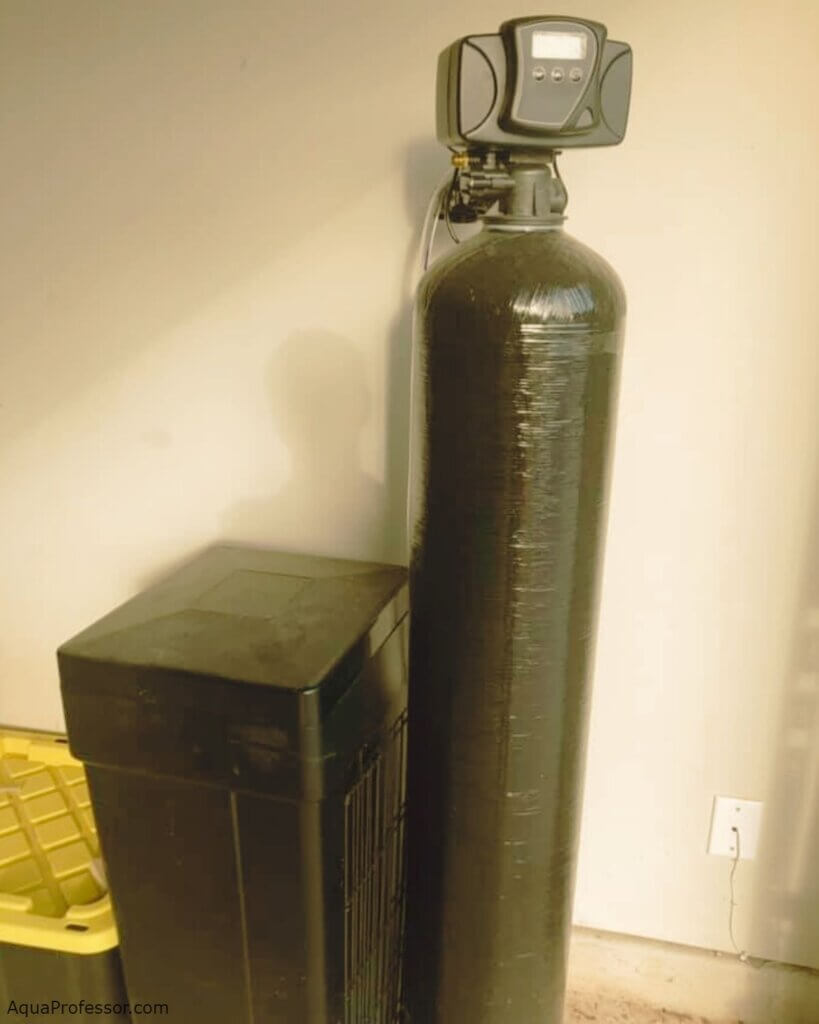
Fleck combines an Iron filter and water softener. With excellent working and added features, Fleck Iron Pro 2 is also a great option to consider if your locality has high Iron content in the water.
Its durable construction is corrosion-resistant and made with non-reactive fiberglass components.
Let’s look further in detail:
The Features We Liked
Fleck Iron Pro 2 has smart features like:
Moreover, in case of a power outage, you get backup power to keep the system working. So you don’t have to re-put the last settings again and again.
What Customers Are Saying
Fleck combination softener has good global customer ratings, with maximum buyers happy with the product.
However, many have complained about the fitting and compatibility issues. Moreover, Fleck’s softener system cannot control extremely high iron levels (beyond 6 ppm).
Reason For Not Selecting
2. Crystal Quest Whole House Water Softening System
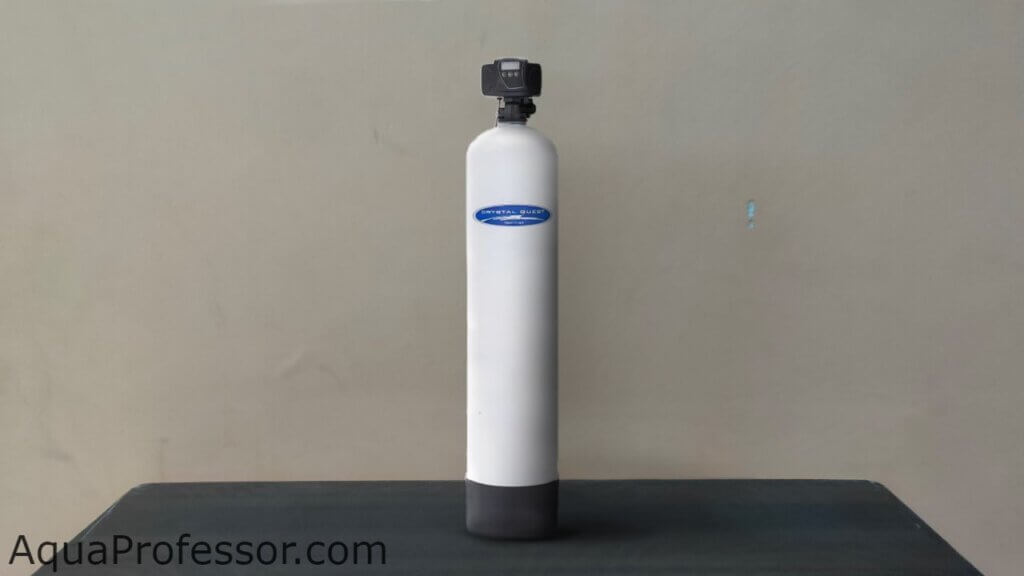
The Crystal Quest Whole house water softener does a great job of removing hard water for house purposes. It has a well-defined and durable construction complimented by an efficient working system.
The Features We Liked
What Customers Are Saying
From the handful of online reviews we found, the customers respond well to the product. The ordering and delivery process is fast and simple.
Reason For Not Selecting
Due to fewer online sales and customer reviews for Crystal Quest, so we have kept it out of our Top 3 list.
3. Pelican NaturSoft Water Softener Alternative
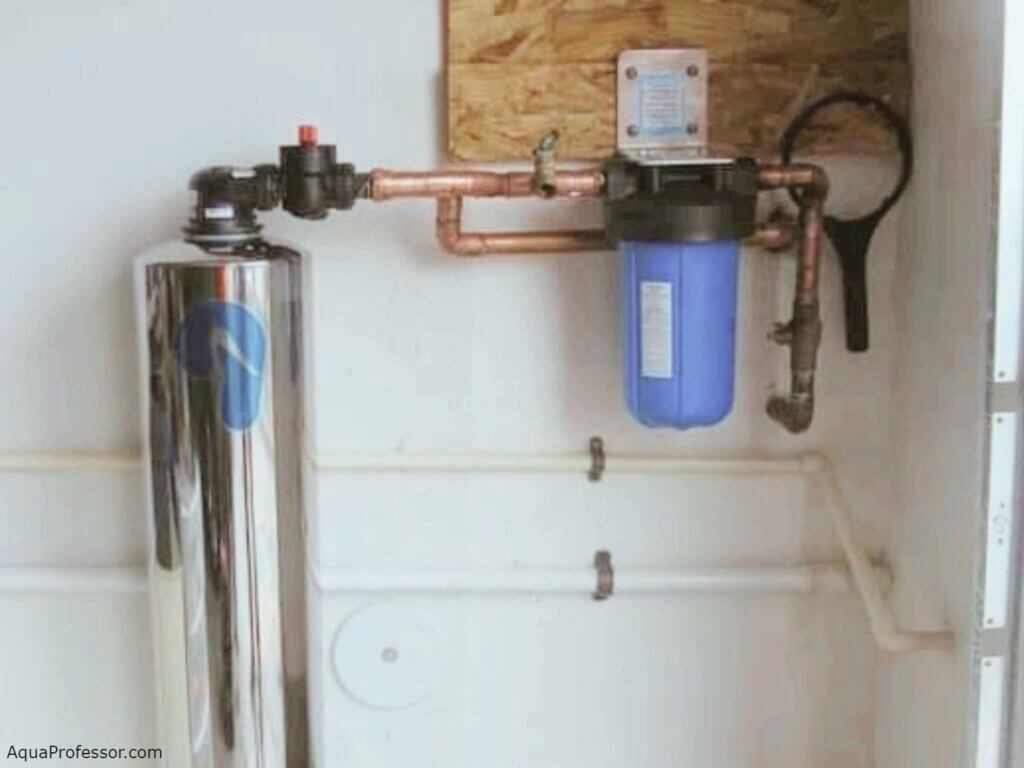
NaturSoft stands out by providing an efficient and salt-free alternative for softening water. Moreover, the device requires very less maintenance.
The Features We Liked
The fact that the softener requires minimum maintenance is a bonus for busy people.
What Customers Are Saying
From the online reviews, we can see that customers appreciate its low maintenance requirements. Customers have also bought this product for multiple homes.
However, the instructions manual needs more detailed instructions, and customers had several installation issues.
Reason For Not Selecting
Customers have faced some leaking issues. While it works well against hard minerals, it cannot be called a complete replacement for salt-based water softeners. The softener has non-standard water connections, which poses many issues in installation.
Also Read: 5 Best Iron Filters in 2024
Expert Buying Guide To Choose Water Softeners For Well Water Contaminants
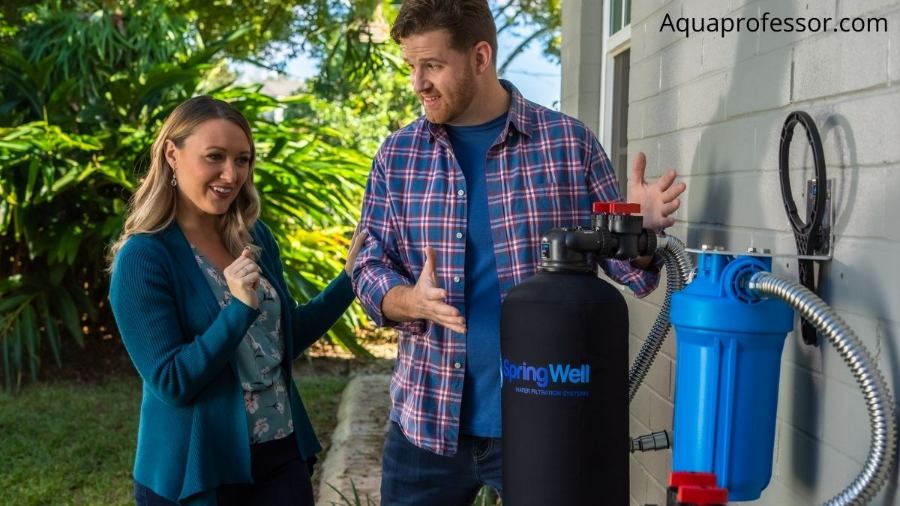
Well Water Hardness
Before buying softeners, you must know the iron levels in your well water. Many DIY water testing kits are available to check the impurity levels at home. However, if you want more elaborate and exact results, go for certified laboratory testing.
What Should You Do?
You can search and locate a testing lab near your location. Then, contact them to collect your water sample from home or directly visit the laboratory with the sample. Depending on their equipment, the results may take one to a few days to deliver.
Softener Capacity
Water softeners come in different grades and sizes. Therefore, you must calculate your water usage and hardness levels to decide the water softener type to buy.
Softener capacity is directly controlled by grain capacity. The higher the grain capacity, the better results you will get.
Also Read: How To Remove Rust From Water Softener?
Water Flow Rate
You wouldn’t be happy if you had to stand for ages to fetch a glass of water from your tap. So, it’s necessary to check the flow rate before the purchase.
The flow rate is usually mentioned in terms of ‘Gallons Per Minute’ and indicates the speed of water flow. An 8-10 GPM flow rate is found satisfactory for most households. Although, if your water consumption is high or you have a large house or family, go for models with higher flow rates.
Ease of Usage and Maintenance
A clean water supply should be the least of your daily worries. Ensure that a regularly required unit, such as a water softener, doesn’t trouble you much after installation.
It should be easy to use, operate and maintain. Maintenance involves replacing the softener’s salt media. The higher the replacement frequency, the costlier it will be to maintain.
Nowadays, water softeners come with a digital control head and a built-in bypass valve. A digital control head makes system settings quick and easy.
Additional information:
A built-in bypass valve allows you to use water even when the water softener breaks down. So, when you turn the bypass on, the water no longer deviates into the softener but directly enters the household pipelines.
Price and Certifications
The budget is the most important aspect for the majority of us. But, unfortunately, it’s not always possible to make a huge investment, even when the problem is serious.
So, make sure you find the best fit within your price limit. However, remember that this investment can save you loads of money in the long run.
Certifications are equally important to check before any purchase in general. Quality products are always certified by the government or higher authorities to ensure that the product functions correctly and the public does not suffer.
NSF (National Sanitation Foundation), ANSI (American National Standards Institute), and WQA (Water Quality Association) are official organizations that offer certification to company products after rigorous testing.
How Do Water Softeners Remove Iron From Well Water?
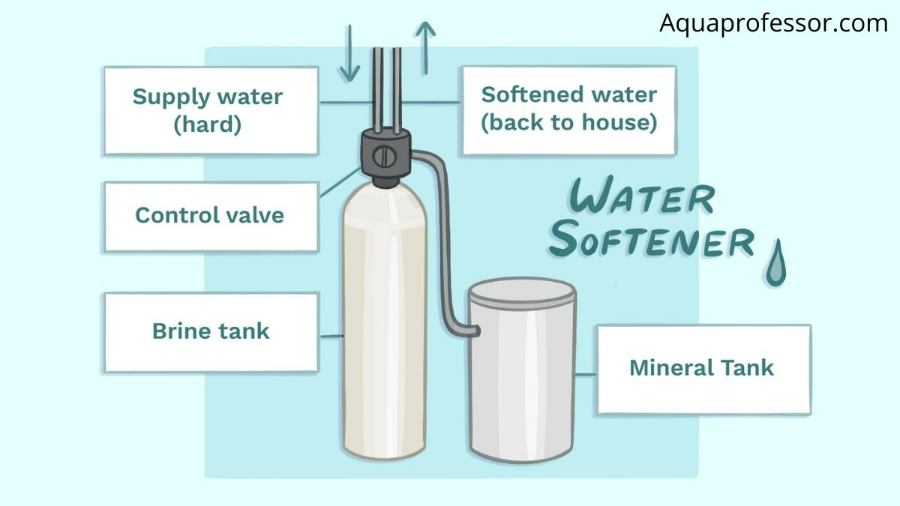
Most water softeners are salt-based systems and work on the principle of the Ion-Exchange mechanism.
A water softener unit includes a main resin tank and a brine tank enclosed within the same housing. The housing has salt pellets that must be regularly refilled and a digital or mechanical meter over the lid.
When the iron-contaminated water enters the softeners, it is diverted into the resin tank, which mixes with the brine water supplied by the salt tank. The resin beads are made of a special polymer, which attracts mineral ions and sticks them to their surface.
In turn, the salt ions (sodium or potassium) are exchanged back into the water, making it soft. So, the water leaving the water softener system is devoid of hardness-causing ferrous iron and thus does not lead to problems like clogging, scaling, or staining.
Note:
Resin beads in ion exchange water softeners can only capture Ferrous ions as Ferric ions are comparatively insoluble and inert.
Why Do You Need To Remove Iron From Well Water?

We agree that iron is abundant on earth and has several benefits. But, as an excess of anything is dangerous, you should be alarmed if your water supply has harmful iron levels. Here are some reasons to remove iron from well water:
Changes In The Aesthetics of Water
Water’s color, taste, and smell are crucial aspects of drinking water. You would never want to drink water that looks discolored, tastes bitter, or has a foul smell.
Unfortunately, high iron levels do exactly that. It gives a reddish-brown tint to the water and tastes bitter. The taste of homemade beverages and food is also affected.
So, if this is the scenario, get your water tested and install a filtration or water-softening system soon.
High Levels are Injurious to Health
Iron-rich water usually doesn’t cause health problems if it’s under the limit of 0.3 ppm. However, at toxic levels, the water does more harm than good.
It may cause:
Thus, keeping your water’s iron levels in check would be best.
Corrosion on Pipelines
Corrosion is the most common problem you can expect due to iron. When iron and its salts come in contact with water and oxygen present in it, rust formation starts. As a result, your plumbing system and metal pipes in water appliances slowly start depleting.
The result?
Leaks and need for replacement. Thus, water softeners or iron filters can help you prevent these extra maintenance costs in the long term.
Rusty Stains on Dishes and Floor
Iron leaves reddish-brown spots on dishes and floors if left unwiped. These stains are enough to make your living difficult; thus, it’s better to install filters or softeners and avoid such problems.
Pigmentation of Skin, Hair, and Clothes
Excessive iron in water causes the degradation of your hair, making it dull and unmanageable. It makes the skin dry and pigmented. The clothes don’t lather with soaps and detergents but, on the contrary, get stained with such water.
Pros and Cons of Using Water Softener To Remove Iron In Well Water
As there are two sides to every story, water softeners also have some advantages and disadvantages. Whether the downsides affect your household or not depends on your situation.
So, go through their pros and cons and decide if they suit your needs:
Pros
- Eliminates hard water.
- Significantly reduces clogging and scaling in pipelines and water appliances.
- No more stains in the clothes, sink, dishes, floors, and toilets.
- Healthier skin and hair
- Better working appliances will lower electricity bills
- Reduced plumbing repair costs.
- Soaps, detergents, and shampoos will last long due to better lathering with less amount.
Cons
- Wastage of water in regeneration cycles.
- You may need another filter to remove excess salt levels from the soft water as it is not good for your health.
- Do not remove chlorine.
- Banned in some states or countries.
Types Of Water Softeners For Iron Removal
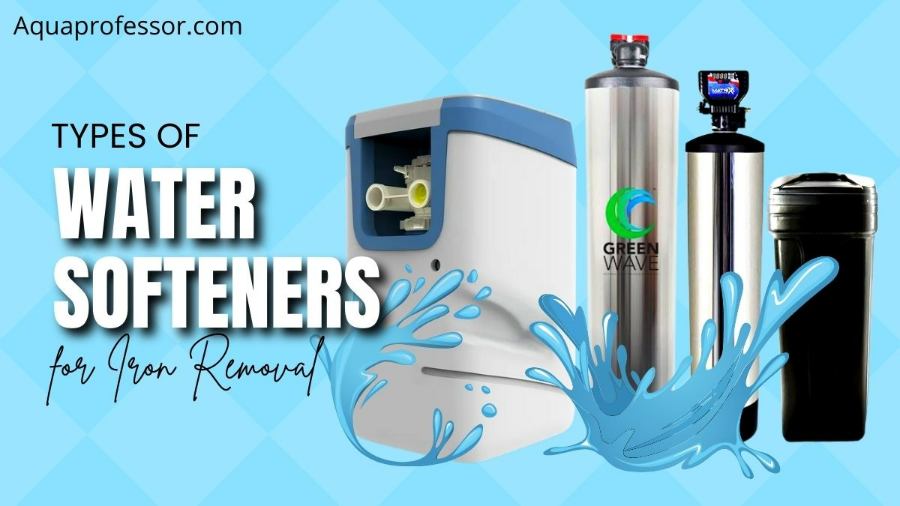
Many types and combos of hardness removal systems are available nowadays. So which one should you go for?
Read below, analyze your situation or needs, and decide for yourself:
Salt-based Water Softeners
These are the most common and widely used systems to get soft water. They remove not only iron but other inorganic minerals as well. They have a main resin tank with thousands of polymer beads to attract mineral ions when water is passed through them.
How Does It Work?
The main tank is connected to the brine tank, which supplies fresh salt solution (brine) containing sodium or potassium. These salt ions replace the hard ions; thus, the water turns soft. You must regularly refill the salt pellets in the water softener brine tank to continuously remove hardness from the water.
Dual Tank Water Softeners
A dual tank water softener is basically two same units working simultaneously. If one shuts down or goes through the regeneration cycle, the other keeps supplying clean, soft water, and vice versa.
These systems are more useful for commercial buildings or places where an uninterrupted water supply is needed. Thus, if you don’t need a 24*7 water supply, a single tank will be good enough to fulfill your water needs and save money.
Water Conditioners
Technically, water conditioners are not water softeners but help prevent hardness problems. They are sometimes referred to as salt-free water softeners, but that’s a misnomer as they do not really soften water.
Water conditioners have a metallic descaler suspended within the system that rearranges mineral ions, including iron, so they repel each other. Thus, the mineral ions cannot accumulate to clog pipelines and remain dispersed in water.
Interesting fact:
You will be interested to know another type of water conditioner that uses TAC (Template-Assisted Crystallization) technology to gather mineral ions to form minute crystals.
These micro-crystals can no longer react with pipelines to cause scaling as they have become inert, nor are they big enough for clogging.
Thus, hardness problems are solved without actually removing the hard minerals. You should also know that water conditioning units are smaller and lighter than water-softening systems.
Iron Filters with Water Softeners
Iron filter + water softener is one of the best combinations you can purchase if you have a major water hardness problem and high iron levels in your water. An iron filter has a resin bed that oxidizes the Ferrous ions into insoluble particles, which are finally removed through a filter membrane.
On the other hand, salt-based softeners also have a main tank with resin beads to attract mineral ions such as iron, calcium, and magnesium. These minerals are replaced with salt ions (sodium or potassium) supplied through the brine tank, and thus, soft water is produced.
So, as you see, an iron filter and a water softener can end all your worries as they complement each other’s working mechanisms to reduce iron and hardness levels. The upfront cost may be high, but its long-term benefits make it worth it.
Difference between Water Softeners and Water Conditioners
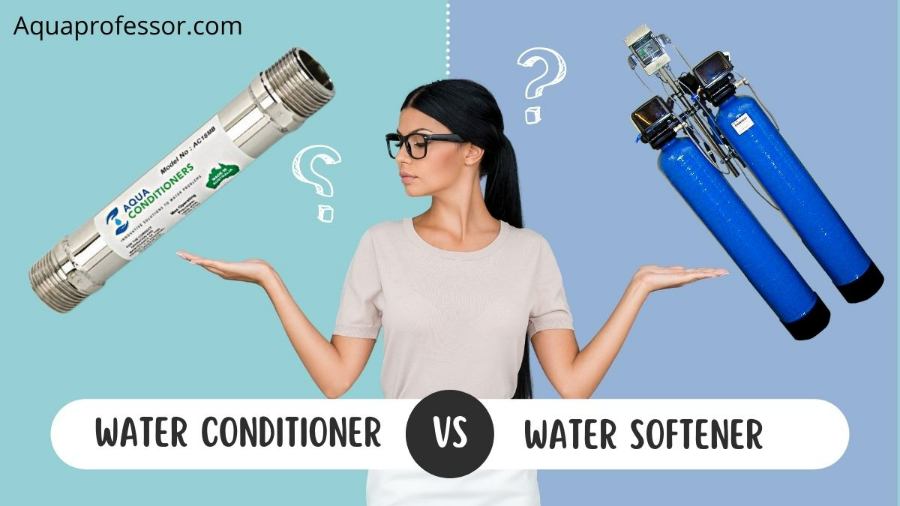
You may be interested to know the difference between water softeners and water conditioners, so here they are:
Water Softener
- It replaces water minerals with salts like Sodium or Potassium.
- It provides soft water.
- It has resin beads in the main tank.
- It does not realign the ions.
- It does not remove chlorine.
- It wastes water.
- Healthy minerals are also removed.
Water Conditioner
- It does not remove the water minerals.
- It does not provide soft water.
- It has a descaler within the main tank.
- It realigns the ions to repel and stay dispersed so they do not accumulate to cause clogging or scaling.
- It removes chlorine.
- It does not waste water.
- Healthy minerals stay in the water.
Who Should Use Water Softeners?
Households with harmful mineral levels in the water supply, including iron, should go for water softeners to avoid plumbing and health problems.
Who Should Use a Water Conditioner?
Households with clogging or scaling problems and high chlorine levels in their water supply can go for salt-free water conditioners. Also, other water mineral levels should be harmless and acceptable.
Water Softener Maintenance Tips
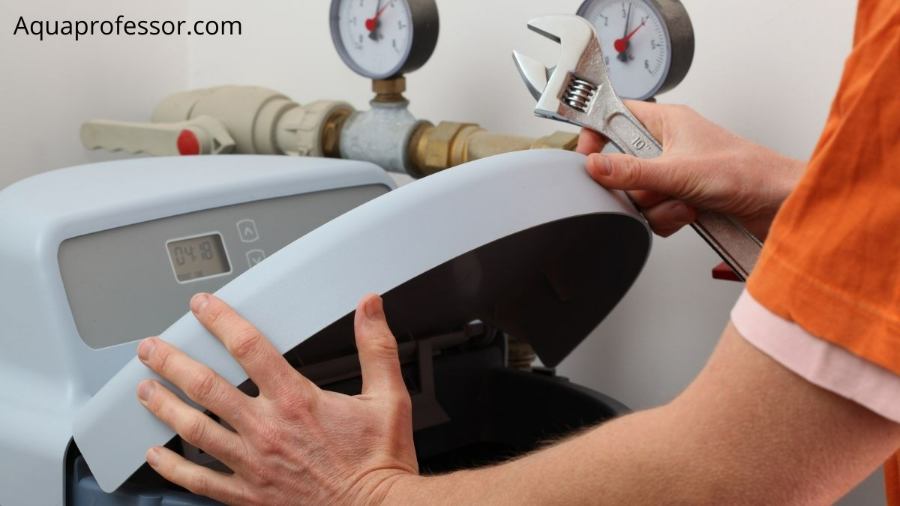
Regular maintenance of softeners should always be on your checklist for a longer lifespan of your device.
Here’re a few pro tips for the smooth functioning of your softening system:
Best Water Softener For Iron Removal FAQs
Phew! Kudos for making it to the end of our super-detailed article. We are hopeful that your search for the best water softener ends here.
If you still have doubts, we have answered some commonly asked questions below:
How much iron can a softener remove?
The amount of iron a water softener can remove depends on its mechanism and quality. Commonly, a 2-5 mg/L removal rate is good enough for many users and is claimed by many manufacturers. However, a few expensive softeners can remove 10 mg/L.
What is considered high iron in well water?
Different states have different guidelines for acceptable levels of minerals in the water. However, iron levels above 0.3 mg/l are objectionable in most of them. You should also know that iron levels above 10 mg/l are alarming and enter a toxic range above 20 mg/l.
How do I test my well water for iron?
There are 2 ways: Certified Laboratory Testing and Home Testing Kit. A home testing kit is easy to purchase and perform, but you may not get the exact results. Laboratory testing is a bit expensive but worthwhile. If the impurity levels are visibly high from the appearance, smell, or taste, go for elaborate laboratory testing. Usually, the mineral content in well water is higher than in city water.
What causes high iron in well water?
As you may already know, iron is the fourth most abundant mineral on the earth’s crust, so it’s no surprise that some leach into underground or well water.
But significant iron concentration in the well occurs due to surface runoff from fields or corrosion in your well water system. Thus, the location and condition of water pipelines are important factors.
How to control iron in well water?
If you want to control iron levels in your well water:
1. Detect the cause.
2. If the cause is corrosion, fix the pipelines.
3. If the cause is natural leeching, install a well water softener system to ensure good water quality in your household.
Alternatively, you can install POE or POU iron filter units to remove heavy iron levels.
Adarsh is a Health & Nutrition Sciences graduate with expertise in environmental health. He is associated with ventures like Glacier Fresh Filter and Simpure Filter Systems. Through Aqua Professor, he intends to provide helpful information to every home to help them make smarter decisions.
